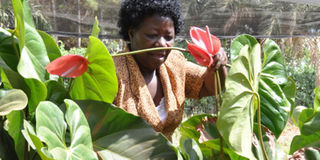Flower exporters want more land, cheap power

Ms Harriet Ssali, a horticulturist, checks on her flowers in a flower farm at Kitegomba village, Kasangati in Wakiso District.Below: A close up of a sunflower. Photo by Rachel Mabala
Flower exporters want more land and subsidised electricity in order to expand their operations in Uganda.
Government’s delay to provide a good incentive regime, has stagnated the flower industry.
Ms Esther Nekambi, Uganda Flower Exporters Association’s (Ufea) programme coordinator, in an interview with Prosper Magazine said: “Our target by 2021 is to have at least 400 hectares up from the current 250 hectares. If land is made available it is expected to attract foreign direct investment worth $300 million (Shs1.1 trillion).”
Ms Nekambi added that the government should attract new investors by giving incentives such as allocate land for this with infrastructure in the form of roads and electricity
Currently, the industry employs over 10,000 people, mostly women (80 per cent) and the number of livelihoods supported by the industry is estimated at 40,000 individuals.
“More workers are indirectly employed in the various floriculture related activities and businesses that support the sector, notably, suppliers of inputs, packaging and cold storage and handling facilities,” she added.
It is estimated that for every direct job created, one and half to two jobs are created in related industries.
Challenges
Even those investors who have persevered the cost of doing business is eating into the profits and this affects the revenues remitted.
“The cost of energy is still prohibitive. Electricity bills per farm on average amount between Shs25m and Shs30m per month. To survive in business, alternative sources of fuel are used such as diesel to run the generators. This, on average, costs them between Shs10m and Shs20m. But this doubles energy costs,” she shared.
The initial costs and availability of finance is a critical matter in the development of commercial agricultural projects.
“This requires heavy investments and the return on your investment will take at least 10 years. The cost of commercial bank loans is still high,” she added.
Other challenges the industry experiences are the high cost of airfreight. The industry survives a lot on pesticides but taxes push up the cost.
Regional status
Cut flower exports earned $423m (Shs1.5 trillion) in the first four months of 2018, a 40.4 percent increase over the same period last year, according to data issued by the country’s National Bureau of Standards.
Kenya is the world’s fourth largest exporter of cut flowers behind the Netherlands, Colombia and Ecuador, and makes up some 7 per cent of global market share, according to Kenya Flower Council data.
In Africa, Ethiopia is the second largest flower producer. The decade old industry has generated high foreign income and created huge employment opportunities.
The Ethiopian government has offered incentives to this industry such as a five-year tax holiday, duty-free imports of machinery, access to bank loans and land have attracted investors.
A 100 per cent exemption from the payment of import customs duties and other taxes levied on imports is granted to investors to cover the importation of investment capital goods such as plant machinery and equipment.




